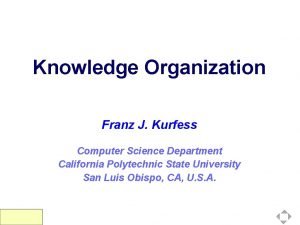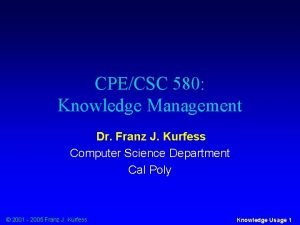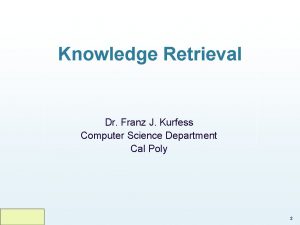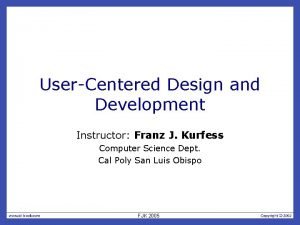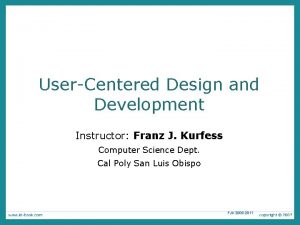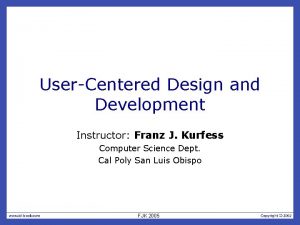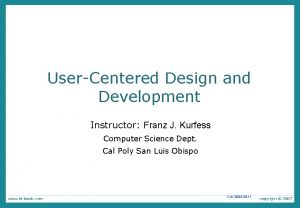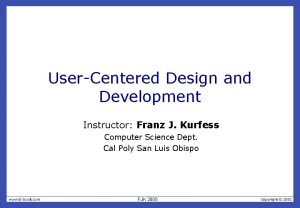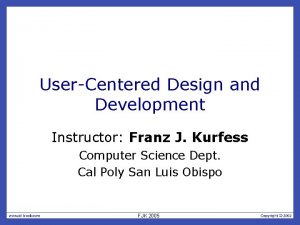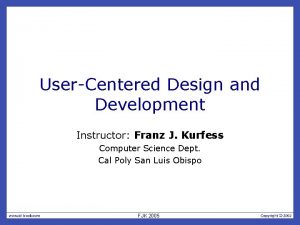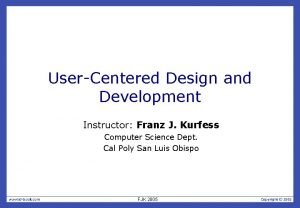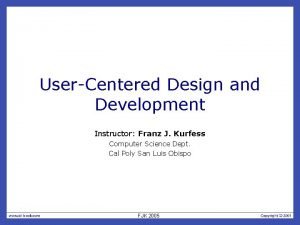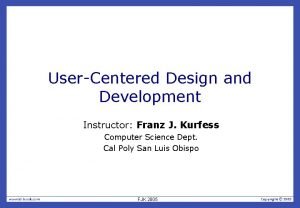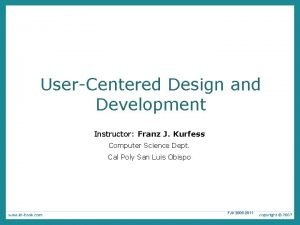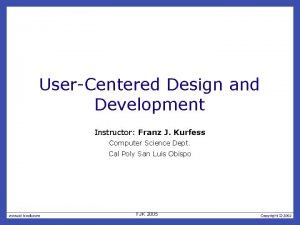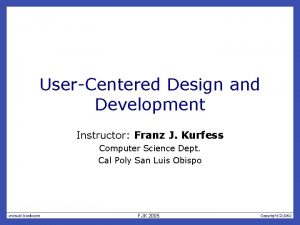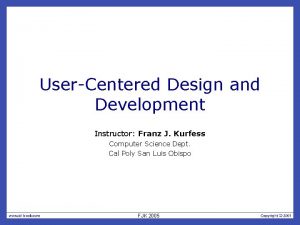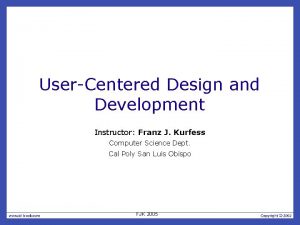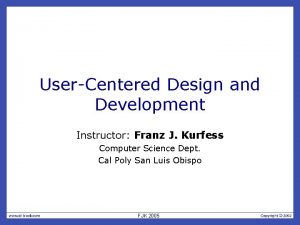UserCentered Design and Development Instructor Franz J Kurfess

























- Slides: 25

User-Centered Design and Development Instructor: Franz J. Kurfess Computer Science Dept. Cal Poly San Luis Obispo FJK 2005

Copyright Notice • • These slides are a revised version of the originals provided with the book “Interaction Design” by Jennifer Preece, Yvonne Rogers, and Helen Sharp, Wiley, 2002. I added some material, made some minor modifications, and created a custom show to select a subset. – Slides added or modified by me are marked with my initials (FJK), unless I forgot it … FJK 2005

484 -W 09 Quarter • The slides I use in class are in the Custom Show “ 484 -W 09”. It is a subset of the whole collection in this file. • Week 6 contains slides from Chapters 10 and 11 of the textbook. • The original slides for this chapter were in much better shape than the ones for previous chapters, and I mainly made changes to better match our emphasis. FJK 2005

Chapter 10 Usability Evaluation Overview FJK 2005

Chapter Overview • • What to evaluate Why evaluate When to evaluate Hutch. World case study FJK 2005

Motivation • provide an overview of usability evaluation • introduce the context, terms, and concepts used FJK 2005

Objectives • Discuss how developers cope with real-world constraints. • Explain the concepts and terms used to discuss evaluation. • Examine how different techniques are used at different stages of development. FJK 2005

Introducing evaluation

Usability Evaluation Aims • Discuss how developers cope with real-world constraints. • Explain the concepts and terms used to discuss evaluation. • Examine how different techniques are used at different stages of development.

Two main types of evaluation • Formative evaluation is done at different stages of development to check that the product meets users’ needs. • Summative evaluation assesses the quality of a finished product. Our focus is on formative evaluation.

What to evaluate • Iterative design & evaluation is a continuous process that examines: – Early ideas for conceptual model – Early prototypes of the new system – Later, more complete prototypes • Designers need to check that they understand users’ requirements.

Why evaluate? Bruce Tognazzini (“Tog”): “Iterative design, with its repeating cycle of design and testing, is the only validated methodology in existence that will consistently produce successful results. If you don’t have user-testing as an integral part of your design process you are going to throw buckets of money down the drain. ” See Ask. Tog. com for topical discussion about design and evaluation.

Activity: Why Evaluate • In your experiences, have you encountered situations that confirm or refute Tog’s take on evaluation? – critical aspects – constraints FJK 2005

When to evaluate • Throughout design – From the first descriptions, sketches etc. of users needs through to the final product • Design proceeds through iterative cycles of ‘design-test-redesign’ • Evaluation is a key ingredient for a successful design.

Evaluating the 1984 OMS • · · · · · Early tests of printed scenarios & user guides Early simulations of telephone keypad An Olympian joined team to provide feedback Interviews & demos with Olympians outside US Overseas interface tests with friends and family. Free coffee and donut tests Usability tests with 100 participants. A ‘try to destroy it’ test Pre-Olympic field-test at an international event Reliability of the system with heavy traffic

Case Study: Hutch. World • distributed virtual community for the Fred Hutchinson Cancer Research Center in Seattle, Wa • developed in collaboration with Microsoft’s Virtual Worlds Research Group • varied groups of users and stakeholders – cancer patients, caregivers, family, friends • enriched chat system to provide support to patients – patients are often isolated since their treatment requires restrictions in physical contact FJK 2005

Development of Hutch. World • Many informal meetings with patients, carers & medical staff early in design • Early prototype was informally tested on site • Designers learned a lot e. g. - language of designers & users was different - asynchronous communication was also needed • Redesigned to produce the portal version

Usability testing • User tasks investigated: - how users’ identity was represented - communication - information searching - entertainment • User satisfaction questionnaire • Triangulation to get different perspectives

Findings from the usability test • The back button didn’t always work • Users didn’t pay attention to navigation buttons • Users expected all objects in the 3 -D view to be clickable. • Users did not realize that there could be others in the 3 -D world with whom to chat, • Users tried to chat to the participant list.

Key points • Evaluation & design are closely integrated in user-centered design. • Some of the same techniques are used in evaluation & requirements but they are used differently – e. g. , interviews, questionnaires • Triangulation involves using a combination of techniques to gain different perspectives • Dealing with constraints is an important skill for evaluators to develop.

Butterfly Ballot Revisited • “The Butterfly Ballot: Anatomy of disaster” – a very interesting account written by Bruce Tognazzini – go to Ask. Tog. com and look through the 2001 column – Alternatively go direct to: http: //www. asktog. com/columns/042 Butterfly. Ballot. html

Activity: Butterfly Ballot for Class Elections • Read Tog’s account and look at the picture of the ballot card. • Make a similar ballot card for a class election – ask 10 of your friends to vote using the card – after each one has voted ask who they intended to vote for and whether the card was confusing – note their comments • Redesign the card and perform the same test with 10 different people. • Report your findings.

Activity: Open. Mail Usability Evaluation Plan • develop a plan for a usability evaluation of the Open. Mail Web client – tasks and users • tasks to be examined, user groups, constraints – data collection • observation, questionnaire, interview, focus group, … – evaluation • important findings, common themes, recommendations for redesign – report • stakeholders • designers and developers

Activity: Open. Mail Usability Evaluation • based on your plan, perform a “quick and dirty” usability evaluation – split your team into users and observers – identify a core set of tasks – if you don’t have a formal questionnaire, use a less formal observation or interview method for data collection – write down the main outcome of the evaluation • problems noted – develop recommendations for improvement • for your recommendations, you can also use general observations – based on your own or anecdotal experience – should be identified as such

 Franz kurfess
Franz kurfess Franz kurfess
Franz kurfess Stephen kurfess
Stephen kurfess Ned kurfess
Ned kurfess Ac 61-65
Ac 61-65 Virtual instructor.com
Virtual instructor.com Tipos de participantes en cursos de capacitación
Tipos de participantes en cursos de capacitación Basic instructor course texas
Basic instructor course texas Basic instructor course texas
Basic instructor course texas Basic instructor course tcole
Basic instructor course tcole Pepperball instructor course
Pepperball instructor course Subject verb agreement exercise
Subject verb agreement exercise Instructor vs teacher
Instructor vs teacher Ospfv
Ospfv Mptc instructor
Mptc instructor Tcole advanced instructor course
Tcole advanced instructor course Basic instructor course texas
Basic instructor course texas Nfpa 1403 instructor to student ratio
Nfpa 1403 instructor to student ratio Tp 12863
Tp 12863 Instructor operating station
Instructor operating station Catia instructor
Catia instructor Instructor
Instructor Tcole 1014 basic instructor course
Tcole 1014 basic instructor course Jrotc marksmanship instructor course online
Jrotc marksmanship instructor course online Nrp instructor toolkit
Nrp instructor toolkit Cisco instructor certification
Cisco instructor certification
